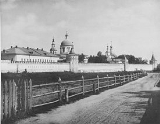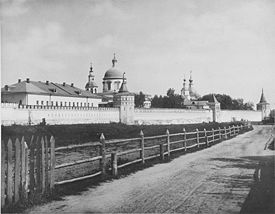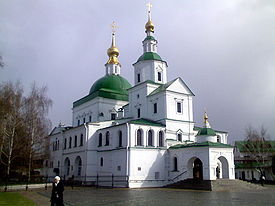
Danilov Monastery
Encyclopedia

Russian language
Russian is a Slavic language used primarily in Russia, Belarus, Uzbekistan, Kazakhstan, Tajikistan and Kyrgyzstan. It is an unofficial but widely spoken language in Ukraine, Moldova, Latvia, Turkmenistan and Estonia and, to a lesser extent, the other countries that were once constituent republics...
), is a monastery
Monastery
Monastery denotes the building, or complex of buildings, that houses a room reserved for prayer as well as the domestic quarters and workplace of monastics, whether monks or nuns, and whether living in community or alone .Monasteries may vary greatly in size – a small dwelling accommodating only...
on the right bank of the Moskva River
Moskva River
The Moskva River is a river that flows through the Moscow and Smolensk Oblasts in Russia, and is a tributary of the Oka River.-Etymology:...
in Moscow
Moscow
Moscow is the capital, the most populous city, and the most populous federal subject of Russia. The city is a major political, economic, cultural, scientific, religious, financial, educational, and transportation centre of Russia and the continent...
, Russia
Russia
Russia or , officially known as both Russia and the Russian Federation , is a country in northern Eurasia. It is a federal semi-presidential republic, comprising 83 federal subjects...
. Since 1983, it has functioned as the headquarters of the Russian Orthodox church
Russian Orthodox Church
The Russian Orthodox Church or, alternatively, the Moscow Patriarchate The ROC is often said to be the largest of the Eastern Orthodox churches in the world; including all the autocephalous churches under its umbrella, its adherents number over 150 million worldwide—about half of the 300 million...
.
History
Danilov Monastery was founded in the late 13th century by Alexander NevskyAlexander Nevsky
Alexander Nevsky was the Prince of Novgorod and Grand Prince of Vladimir during some of the most trying times in the city's history. Commonly regarded as the key figure of medieval Rus, Alexander was the grandson of Vsevolod the Big Nest and rose to legendary status on account of his military...
's son Daniil. Shortly before his death in 1303, Danilo took monastic vows and later was buried at Danilov Monastery. The Russian Orthodox church
Russian Orthodox Church
The Russian Orthodox Church or, alternatively, the Moscow Patriarchate The ROC is often said to be the largest of the Eastern Orthodox churches in the world; including all the autocephalous churches under its umbrella, its adherents number over 150 million worldwide—about half of the 300 million...
venerates him as a saint
Saint
A saint is a holy person. In various religions, saints are people who are believed to have exceptional holiness.In Christian usage, "saint" refers to any believer who is "in Christ", and in whom Christ dwells, whether in heaven or in earth...
. The very first Muscovite archmandrite came from this monastery in 1300.
In the 14th - 15th centuries, Danilov Monastery fell into decline. In 1560, Ivan the Terrible brought it back to life. In 1591, when the armies of a Crimean
Crimean Khanate
Crimean Khanate, or Khanate of Crimea , was a state ruled by Crimean Tatars from 1441 to 1783. Its native name was . Its khans were the patrilineal descendants of Toqa Temür, the thirteenth son of Jochi and grandson of Genghis Khan...
khan
Khan (title)
Khan is an originally Altaic and subsequently Central Asian title for a sovereign or military ruler, widely used by medieval nomadic Turko-Mongol tribes living to the north of China. 'Khan' is also seen as a title in the Xianbei confederation for their chief between 283 and 289...
Kaza Giray approached Moscow, the area around Danilov Monastery was turned into a fortified mobile camp.

Ivan Bolotnikov
Ivan Isayevich Bolotnikov was the leader of a popular uprising in Russia in 1606–1607 known as the Bolotnikov rebellion . The uprising was part of the Time of Troubles in Russia.-Biography:...
and Istoma Pashkov collided with the army of Vasili IV
Vasili IV of Russia
Vasili IV of Russia was Tsar of Russia between 1606 and 1610 after the murder of False Dmitriy I. His reign fell during the Time of Troubles....
not far from the monastery. In 1607, an impostor
Impostor
An impostor or imposter is a person who pretends to be somebody else, often to try to gain financial or social advantages through social engineering, but just as often for purposes of espionage or law enforcement....
by the name of Ileyka Muromets, who had pretended to be tsarevich Peter (son of Feodor I of Russia
Feodor I of Russia
Fyodor I Ivanovich 1598) was the last Rurikid Tsar of Russia , son of Ivan IV and Anastasia Romanovna. In English he is sometimes called Feodor the Bellringer in consequence of his strong faith and inclination to travel the land and ring the bells at churches. However, in Russian the name...
), was executed next to Danilov Monastery. Being in the center of many military events during the Time of Troubles
Time of Troubles
The Time of Troubles was a period of Russian history comprising the years of interregnum between the death of the last Russian Tsar of the Rurik Dynasty, Feodor Ivanovich, in 1598, and the establishment of the Romanov Dynasty in 1613. In 1601-1603, Russia suffered a famine that killed one-third...
, the monastery was severely damaged in 1610. In the early 17th century, it was surrounded by a brick wall with seven towers.
In 1710, there were 30 monk
Monk
A monk is a person who practices religious asceticism, living either alone or with any number of monks, while always maintaining some degree of physical separation from those not sharing the same purpose...
s in Danilov Monastery. In 1764, there were only twelve of them on staff. By 1900, however, the number rose to seventeen. Among the monks who lived in Danilov Monastery during its history was the renowned Greek scholar Nikephoros Theotokis
Nikephoros Theotokis
Nikephoros Theotokis or Nikiforos Theotokis was a Greek scholar and theologian, who became an archbishop in the southern provinces of the Russian Empire...
, who retired to this monastery in 1792 from his bishop
Bishop
A bishop is an ordained or consecrated member of the Christian clergy who is generally entrusted with a position of authority and oversight. Within the Catholic Church, Eastern Orthodox, Oriental Orthodox Churches, in the Assyrian Church of the East, in the Independent Catholic Churches, and in the...
's position in South Russia, and lived here until his death in 1800.
In 1805, an almshouse
Almshouse
Almshouses are charitable housing provided to enable people to live in a particular community...
for elderly women was established at the monastery; later it was turned into an almshouse
Almshouse
Almshouses are charitable housing provided to enable people to live in a particular community...
for elderly clergymen and their widows.
In 1812, the monastery was ransacked by the French army. The monasterial sacristy
Sacristy
A sacristy is a room for keeping vestments and other church furnishings, sacred vessels, and parish records.The sacristy is usually located inside the church, but in some cases it is an annex or separate building...
and treasury
Treasury
A treasury is either*A government department related to finance and taxation.*A place where currency or precious items is/are kept....
, however, had been transported to Vologda
Vologda
Vologda is a city and the administrative, cultural, and scientific center of Vologda Oblast, Russia, located on the Vologda River. The city is a major transport knot of the Northwest of Russia. Vologda is among the Russian cities possessing an especially valuable historical heritage...
and Troitse-Sergiyeva Lavra
Troitse-Sergiyeva Lavra
The Trinity Lavra of St. Sergius is the most important Russian monastery and the spiritual centre of the Russian Orthodox Church. The monastery is situated in the town of Sergiyev Posad, about 70 km to the north-east from Moscow by the road leading to Yaroslavl, and currently is home to...
shortly before the French occupied Moscow.
First documented information on Danilov Monastery's landownership can be traced back to 1785, when it owned 18 desyatinas of land. By the end of the 19th century, the monastery had already possessed 178 desyatinas and a few buildings in Moscow
Moscow
Moscow is the capital, the most populous city, and the most populous federal subject of Russia. The city is a major political, economic, cultural, scientific, religious, financial, educational, and transportation centre of Russia and the continent...
.
In the second half of the 19th century, Danilov Monastery's cemetery was a final resting place for many writers, artists and scientists, such as Nikolai Gogol
Nikolai Gogol
Nikolai Vasilievich Gogol was a Ukrainian-born Russian dramatist and novelist.Considered by his contemporaries one of the preeminent figures of the natural school of Russian literary realism, later critics have found in Gogol's work a fundamentally romantic sensibility, with strains of Surrealism...
, Nikolai Yazykov, Vasili Perov, Nikolai Rubinstein and many others. The remains of most of them, however, were transported in Soviet years to the Novodevichy Cemetery
Novodevichy Cemetery
Novodevichy Cemetery is the most famous cemetery in Moscow, Russia. It is next to the 16th-century Novodevichy Convent, which is the city's third most popular tourist site. It should not be confused with the Novodevichy Cemetery in Saint Petersburg....
. By 1917, Danilov Monastery had 19 monks and four novice
Novice
A novice is a person or creature who is new to a field or activity. The term is most commonly applied in religion and sports.-Buddhism:In many Buddhist orders, a man or woman who intends to take ordination must first become a novice, adopting part of the monastic code indicated in the vinaya and...
s and owned 164 desyatinas of land.
After the October Revolution
October Revolution
The October Revolution , also known as the Great October Socialist Revolution , Red October, the October Uprising or the Bolshevik Revolution, was a political revolution and a part of the Russian Revolution of 1917...
, the monastery housed archimandrite
Archimandrite
The title Archimandrite , primarily used in the Eastern Orthodox and the Eastern Catholic churches, originally referred to a superior abbot whom a bishop appointed to supervise...
s who had been deprived of their pulpit
Pulpit
Pulpit is a speakers' stand in a church. In many Christian churches, there are two speakers' stands at the front of the church. Typically, the one on the left is called the pulpit...
s. In 1929, the Soviets issued a special decree on closing the monastery and organizing a detention facility on its premises under the auspices of NKVD
NKVD
The People's Commissariat for Internal Affairs was the public and secret police organization of the Soviet Union that directly executed the rule of power of the Soviets, including political repression, during the era of Joseph Stalin....
(приёмник-распределитель НКВД , or priyomnik-raspredelitel' NKVD). The last monastery closed in Moscow became the first one to be returned in 1983 to the Moscow Patriarchy and became a spiritual and administrative centre of the Russian Orthodox Church
Russian Orthodox Church
The Russian Orthodox Church or, alternatively, the Moscow Patriarchate The ROC is often said to be the largest of the Eastern Orthodox churches in the world; including all the autocephalous churches under its umbrella, its adherents number over 150 million worldwide—about half of the 300 million...
. In 1988, the monastery was restored. A residence was built for the Patriarch and Synod
Synod
A synod historically is a council of a church, usually convened to decide an issue of doctrine, administration or application. In modern usage, the word often refers to the governing body of a particular church, whether its members are meeting or not...
, as well as a funeral chapel
Chapel
A chapel is a building used by Christians as a place of fellowship and worship. It may be part of a larger structure or complex, such as a church, college, hospital, palace, prison or funeral home, located on board a military or commercial ship, or it may be an entirely free-standing building,...
and a chapel in commemoration of the 1000 years of Russia's baptism
Baptism of Kievan Rus'
The Christianization of Kievan Rus took place in several stages. In early 867, Patriarch Photius of Constantinople announced to other Orthodox patriarchs that the Rus', baptised by his bishop, took to Christianity with particular enthusiasm...
.
Bells
When the monastery was closed in 1929 and 1930, its bell set was saved from CommunistCommunism
Communism is a social, political and economic ideology that aims at the establishment of a classless, moneyless, revolutionary and stateless socialist society structured upon common ownership of the means of production...
melting through the purchase by American industrialist Charles R. Crane. The largest of the bells, Bolshoi (or The Big One - called The Mother Earth Bell at Harvard), weighs 13 tons and has a 700 pound clapper. The smallest weighs just 22 pounds. Crane donated the bells to Harvard University
Harvard University
Harvard University is a private Ivy League university located in Cambridge, Massachusetts, United States, established in 1636 by the Massachusetts legislature. Harvard is the oldest institution of higher learning in the United States and the first corporation chartered in the country...
and they were installed in the main tower of Harvard's Lowell House
Lowell House
Lowell House is one of the twelve undergraduate residential houses within Harvard College, located on Holyoke Place facing Mount Auburn Street between the Harvard Yard and the Charles River...
and at the Harvard Business School's Baker Library. Beginning in the 1980s, with openness under Gorbachev, there were calls to return the bells, and after numerous meetings over the years, the bells were returned to the Russian Orthodox Church in the fall of 2008 . Russian industrialist Viktor Vekselberg
Viktor Vekselberg
Viktor Felixovich Vekselberg is the owner and president of Renova Group, a large Russian conglomerate.-Business empire:Victor Vekselberg was born in 1957 in Western Ukraine. He graduated from the Moscow Transportation Engineering Institute in 1979...
, famous for buying up a number of Faberge Egg
Fabergé egg
A Fabergé egg is any one of the thousands of jeweled eggs made by the House of Fabergé from 1885 to 1917. Most were miniature eggs that were popular gifts at Eastertide...
s, agreed to pay for the repatriation of the 18 bells and for the cost of casting replacements of them in Russia to be hung at Harvard. The first of the bells, known as the Everyday (or Weekday) Bell, weighing 2.2 tons, arrived at the Danilov Monastery on September 12, 2007; the remaining seventeen were returned on September 12, 2008.
External links
- Official site of the Danilov Monastery
- Orthodox Moscow - Churches, Cathedrals, Convents and Monasteries in Moscow
- Danilov Monastery Choir Music for listening, text in Russian

